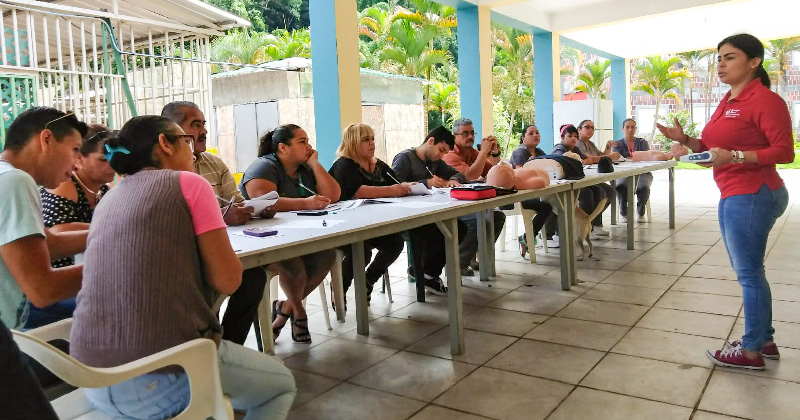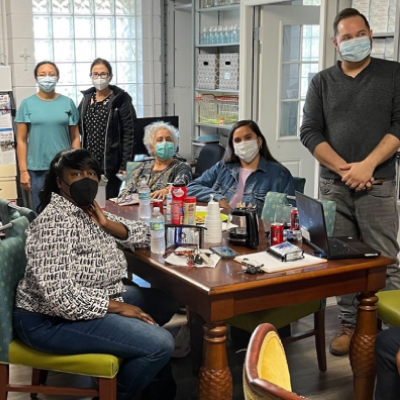- Who We Are
- Clinician Employment
- Publications
- Witness to Witness (W2W)
- Kugel & Zuroweste Health Justice Award
- Your Voice Matters: Photovoice Project
How to Communicate Preventative Measures in Times of Panic: Prepare before the onset of an emergency. And, if you can’t start early, then at least start now.
Tue, 03/24/2020 | by Claire Hutkins Seda


Community members in Puerto Rico attend a first aid training.
Alondra is a 37-year-old who lives with her family in a small one-bedroom apartment. As the coronavirus hits her community, she begins to have lots of questions. If I get sick, how can I keep my daughters and husband away from me in such a small space, when I usually sleep in the living room? Who will take care of my two children if both my husband and I get sick? How will we get medication? Who should we contact? How much will an appointment cost? Who will get my mother’s medications for her and check in on her, if I am isolated or quarantined?
“Community mobilization is about good communication strategies,” explained Alma Galván, MCH, Migrant Clinicians Network’s Senior Program Manager of Environmental and Occupational Health. “Have a personal plan on what to do: who I will communicate with, who will take care of my kids, who are my contacts at the community health center -- and have those lines of communication ready.” Once that personal plan has been outlined, Galván recommends Alondra take the next step in creating a plan for her family in an emergency. Then, work with the entire neighborhood or small community to develop a community-wide plan. Critically, all the plans should intentionally overlap.
“The personal and family plans should then feed into the bigger community-wide plan,” Galván said. And the community plan should enable the communication channels to be established and, most critically, maintained or activated during an emergency.
For such a community plan scaffolding to work, the community health center partners with community leaders to build an emergency plan that details down to each individual house. Rather than the more common and less labor-intensive approach, wherein strategies are guided by what a majority of patients need, a community mobilization plan of this scale will allow clinicians to know exactly what each community member -- particularly the most vulnerable or disconnected -- would need in the case of an emergency: who needs to be prioritized for a check-in; whose medication interruption is the most pressing for the pharmacy to address; who requires food assistance; who has no transportation, etc.
It is this community mobilization approach that is working in Puerto Rico. Migrant Clinicians Network piloted this strategy with two health centers last year and is now working with an additional four centers as part of our “Mobilizing Communities in Puerto Rico to Meet the Needs of Vulnerable Populations Before, During, and After a Natural Disaster,” a multi-year project funded by the Bristol-Myers Squibb Foundation that will impact eight communities across the island. Now in its second year, the project is proving useful for health centers to adapt the approach to enable effective risk communication about coronavirus.
“Community mobilization allows us to know our community profile: who are our most vulnerable, and how we can support them. Lines of communication open up, from the health center to the community, and vice versa,” explained Marysel Pagán Santana, MS, DrPH, Migrant Clinicians Network’s Program Manager in Puerto Rico. At a training for MCN’s Mobilizing Communities project in San Juan, Puerto Rico last week, Dr. Pagán Santana led an activity with health center workers around risk communication, demonstrating how the community mobilization plans can figure into communication strategies around COVID-19.
“How do you talk with an elderly person, with a mom, with a child? How do you talk with people in the ER? What about at a school?” Dr. Pagán Santana questioned. “You need to tailor the message to the audience. To do risk communication effectively, you have to know your community, so you can share the messages you need in a way that everyone can understand.”
Children, for example, may not understand that they may not feel very sick, but could be carriers of the virus -- and that the virus can be very serious for other members of our community. “Do not just disregard a segment of the community just because they’re not getting sick,” Dr. Pagán Santana noted. She pointed to incidents around the US where health authorities are asking healthy young citizens to disperse, and many are disregarding the messages. “A lack of tailored risk communication is what’s getting us into such situations,” she added.
Community mobilization is a long-term endeavor that builds a community-organized and community-centered safety net in the case of disruption, be it a hurricane or a virus. Two health centers in Puerto Rico and their respective communities developed and began implementing their plans last year; four more health centers are working with their communities to build their plans this year. In the meantime, all health centers can begin to utilize some of the strategies of community mobilization as we face down this unprecedented COVID-19 emergency in our communities.
“Keep the lines of communication open,” Dr. Pagán Santana said, by building networks, partnering with community leaders, beginning to build lists of the most vulnerable, and checking-in directly with the most vulnerable patients. She also recommended health centers assist community members in steps to outline personal and family plans and communicate those plans with the larger community.
“The response to the public health emergency that we are experiencing rests for the most part on the solidarity and understanding of the members of our communities -- but the empathy and action of these members will be proportional to the accurate and concise information they receive,” Dr. Pagán Santana said. “Assigning responsibility to all members of the community, whether staying at home or supporting establishing mechanisms for distributing medicines to people who cannot otherwise acquire them or whose conditions can be complicated if exposed, can strengthen the government response and decrease the burden on the health system.”
Resources
Here are some resources for communities to build their own community mobilization plans.
Centers of Disease Control and Prevention’s Crisis & Emergency Risk Communication (CERC)
The Social and Behavior Change Communication for Emergency Preparedness Implementation Kit’s Unit 3: Community Mobilization – Emergency Communication Preparedness
CDC’s Community Mobilization Guide
CDC’s Pandemic Preparedness Resources
CDC’s Get Your Household Ready for Pandemic Flu
Here are some resources for communities to build their own community mobilization plans.
Centers of Disease Control and Prevention’s Crisis & Emergency Risk Communication (CERC)
The Social and Behavior Change Communication for Emergency Preparedness Implementation Kit’s Unit 3: Community Mobilization – Emergency Communication Preparedness
CDC’s Community Mobilization Guide
CDC’s Pandemic Preparedness Resources
CDC’s Get Your Household Ready for Pandemic Flu
Like what you see? Amplify our collective voice with a contribution.
Got some good news to share? Contact us on our social media pages above.
Return to the main blog page or sign up for blog updates here.







